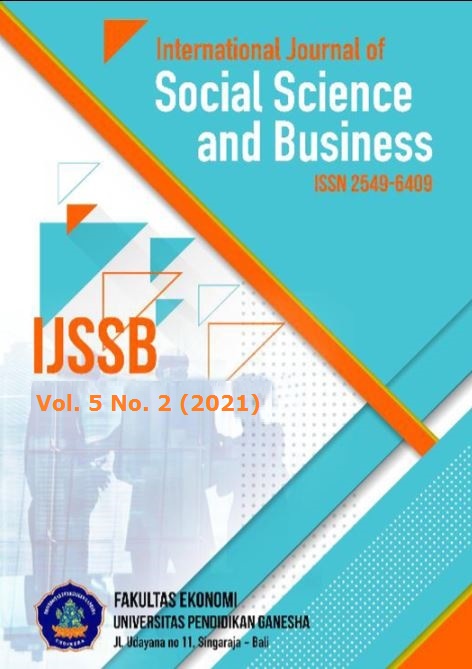The Implication of Self-Relevant and Travelling Consumption on Propensity to Share e-WOM
DOI:
https://doi.org/10.23887/ijssb.v5i2.30246Keywords:
Appraisal of Self, Conspicuous Value, Self-Image Congruity, Desire for Experience Travel, Need for Uniqueness, Social Esteem, Electronic Word of MouthAbstract
This study aims to examine the effect of 3 dimensions of self-relevant value (Reflected Appraisal of Self, Conspicuous Value, and Self-Image Congruity) and 3 dimensions of value of traveling consumption (Desire for Experience Travel, Need for Uniqueness, and Social Esteem) on the tendency for someone to share their experiences on social media (e-WOM). To answer the research objectives, this study uses a quantitative research design using cross sectional time dimension of the study. The questionnaire was used as a sample data collection tool, in which the sampling was done purposively. The data collection method used in this study is by distributing online questionnaires by inserting questionnaires into Google Form, then online questionnaires are distributed through social media such as Facebook, Instagram, and WhatsApp. Appropriate respondents to fill out this questionnaire are people who have visited popular tours in Indonesia, especially young tourists. Data analysis method is planned using Multiple Regression Analysis. The results show that four of the six hypotheses are proven in this study. There are two hypotheses that are rejected, specifically the relationship between conspicuous value on propensity to share e-WOM, and the relationship between self-esteem on propensity to share e-WOM. This study gives a contribution to the body of knowledge on the relationship between self-relevant value and desire to experience travel concepts on propensity of travellers to share their experience on the electronic Word of Mouth (e-WOM).
References
Beerli, A., & Martin, J. D. (2004). Factors influencing destination image. Annals of Tourism Research, 31(3), 657–681. https://doi.org/10.1016/j.annals.2004.01.010.
Black, W. C., Babin, B. J., & Anderson, R. E. (2010). Multivariate data analysis: A global perspective. Pearson Education Inc.
Bolwijn, R., Casella, B., & Zhan, J. (2018). International production and the digital economy. In Progress in International Business Research (Vol. 13, pp. 39–64). Emerald Group Publishing Ltd. https://doi.org/10.1108/S1745-886220180000013003.
Bonn, M. A., Joseph, S. M., & Dai, M. (2005). International versus domestic visitors: An examination of destination image perceptions. Journal of Travel Research, 43(3), 294–301. https://doi.org/10.1177%2F0047287504272033.
Bronner, F., & De Hoog, R. (2008). Agreement and disagreement in family vacation decision-making. Tourism Management, 29(5), 967–979. https://doi.org/10.1016/j.tourman.2007.12.001.
Cheung, C. M., & Lee, M. K. (2012). What drives consumers to spread electronic word of mouth in online consumer-opinion platforms. Decision Support Systems, 53(1), 218–225. https://doi.org/10.1016/j.dss.2012.01.015.
Cooper, D. R., & Schindler, P. S. (2003). Bussiness Research Methods (8th ed.). McGrow-Hill.
Dadgostar, B., & Isotalo, R. M. (1996). Content of city destination image for near-home tourists. Journal of Hospitality & Leisure Marketing, 3(2), 25–34. https://doi.org/10.1300/J150v03n02_03.
Eastman, J. K., Iyer, R., Liao-Troth, S., Williams, D. F., & Griffin, M. (2014). The role of involvement on millennials’ mobile technology behaviors: The moderating impact of status consumption, innovation, and opinion leadership. Journal of Marketing Theory and Practice, 22(4), 455–470. https://doi.org/10.2753/MTP1069-6679220407.
Ek Styvén, M., & Foster, T. (2018). Who am I if you can’t see me? The “self” of young travellers as driver of eWOM in social media. Journal of Tourism Futures, 4(1), 80–92. https://doi.org/10.1108/JTF-12-2017-0057.
Gartner, W. C. (1994). Image formation process. Journal of Travel & Tourism Marketing, 2(2–3), 191–216. https://doi.org/10.1300/J073v02n02_12.
Ghozali, I. (2014). Structural Equation Modeling, Metode Alternatif dengan Partial Least Square (PLS). Badan Penerbit Universitas Diponegoro.
Goldsmith, R. E., & Horowitz, D. (2006). Measuring motivations for online opinion seeking. Journal of Interactive Advertising, 6(2), 2–14. https://doi.org/10.1080/15252019.2006.10722114.
Hernandez, L., Fernandez, & Baptista. (2006). Metodologia de la investigacion (4th ed.). McGraw Hill.
Jalilvand, M. R., & Samiei, N. (2012). The effect of electronic word of mouth on brand image and purchase intention: An empirical study in the automobile industry in Iran. Marketing Intelligence & Planning, 30(4). https://doi.org/10.1108/02634501211231946.
Jeong, E., & Jang, S. S. (2011). Restaurant experiences triggering positive electronic word-of-mouth (eWOM) motivations. International Journal of Hospitality Management, 30(2), 356–366. https://doi.org/10.1016/j.ijhm.2010.08.005.
Kim, D., Jang, S. S., & Alder, H. (2015). What Drivers Café Customers to Spread E-WOM? Examining Self-Relevant Value, Quality Value, and Opinion Leadership. International Journal of Contemporary Hospitality Management, 27(2), 1–40. https://doi.org/10.1108/IJCHM-06-2013-0269.
Litvin, S. W., Goldsmith, R. E., & Pan, B. (2008). Electronic word-of-mouth in hospitality and tourism management. Tourism Management, 29(3), 458–468. https://doi.org/10.1016/j.tourman.2007.05.011.
Munar, A. M., & Jacobsen, J. K. S. (2013). Trust and involvement in tourism social media and web-based travel information sources. Scandinavian Journal of Hospitality and Tourism, 13(1), 1–19. https://doi.org/10.1080/15022250.2013.764511.
Pearce, P. L. (1982). Perceived changes in holiday destinations. Annals of Tourism Research, 9(2), 145–164. https://doi.org/10.1016/0160-7383(82)90044-5.
Phelps, A. (1986). Holiday destination image—the problem of assessment: An example developed in Menorca. Tourism Management, 7(3), 168–180. https://doi.org/10.1016/0261-5177(86)90003-8.
Sekaran, U. (2009). Metodology Penelitian untuk Bisnis (4th ed.). Salemba Empat.
Sirgy, M. J., & Su, C. (2000). Destination image, self-congruity, and travel behavior: Toward an integrative model. Journal of Travel Research, 38(4), 340–352. https://doi.org/10.1177%2F004728750003800402.
Tapscott, D. (1997). The digital economy : promise and peril in the age of networked intelligence. Mc Grawhill.
Wang, Y., & Fesenmaier, D. R. (2004). Modeling participation in an online community. Journal of Travel Research, 42(3), 261–270. https://doi.org/10.1177%2F0047287503258824.
Wojnicki, A. C., & Godes, D. (2008). Word-of-Mouth as self-enhancement. HBS Marketing Research Paper, 6(1). https://papers.ssrn.com/sol3/papers.cfm?abstract_id=908999.











